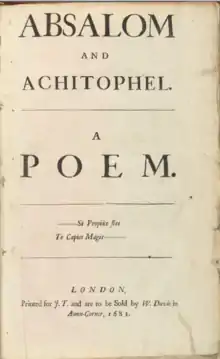Gender novels
A gender novel is a type of novel that features gender, or the concept of gender, as a central theme to the plot or idea of the novel. The concept of gender may be used to initiate debate regarding gender stereotypes, gender equality or the reversal of genders within books. This term can be used as a synonym for gendered fiction. Gender novels also may be categorised not only under the genre of gendered fiction but crime, fantasy, and science-fiction.
For a novel to be considered a gender novel, the plot, characters or context must play with the concept of gender and gendered themes. This may be the inclusion of transgender or androgynous characters, the development of gender focused conflicts throughout the novel or a setting in which gender may or may not be a framework for societies to function. Gender novels are used to respond to contemporary issues within societies in regards to the perception of gender across the world. They can also be used to express sentiments or arguments relating to the disagreement regarding the concept of gender.
Famous gender novels include Ursula Le Guin's Left Hand of Darkness, and Markus Zusak's The Book Thief. Many of these gender novels have been critically acclaimed for their groundbreaking theories surrounding gender roles. Gender novels, as a contemporary genre, has its foundations in the late 1940s. Later on in the 21st century, the works of Jeffrey Eugenides, Jeff Garvin and Jessica Herthel broke stereotypical gender norms and attempted to warp traditionalist gender views.
Background
History of gender in literature up until the 19th century
.JPG.webp)
Gender in literature mostly reflected how gender was seen in society in that specific time period. It is important to understand how society saw the roles of men and women as it translated into the literature published during that time. Gender throughout the 17th, 18th and 19th century all over the world was set in stone and attempting to break away from these roles was unheard of and foreign. Women were required to wear, act and behave a certain way both in public and in the private home. Life back then was extremely patriarchal, with opportunities, power and respect reserved for men only. Prior to the 17th century, men would play women's roles in old Shakespearean plays and musicals.[1] Cross-gender acting is seen as evidence of the fact that women were not typically included or invited to participate in the arts, literature and musical theatrics.
Throughout the 17th century, women played a significant role through primarily domestic activities such as taking on the responsibilities of being a chef, cleaner, counsellor, wife, mother and seamstress. Women were discouraged from expressing their opinion with things relating to politics, money and other contemporary issues.[2] Due to their overall submissive role, most literature that was produced during this time was patriarchal, and heavily featured the activities and achievements of men. The women who were educated and capable of writing were discouraged from pursuing their talent, as it was deemed by society as an inappropriate hobby for women. Women were able to publish their own written work, however, only if they were portrayed as submissive and inferior as these were the writings in the 17th century that would be popular and accurate.[3] The more domestic role of women is reflected in their history, which was based mostly on their first and foremost duty to serve the needs of men and the patriarchy.

During the 18th century, women were still seen as the far more submissive sex; however, the beginning of the cultural revolution in Britain brought about changes to the roles of women. Women were now more frequently assisting their husbands in work, and even began having a better access to education. Despite this, women were still taught to behave in a certain way. Throughout the cultural revolution, women were still victims of both economic and social discrimination. Their career choices were still restricted to marriage, motherhood, nursing or teaching, with their primary role as being childbearers and wives.[4] Literature however, still primarily focused on men, which still reflects this rigid construct of gender. Nevertheless, works such as John Dryden's prose Absalom and Achitophel have depicted an 18th-century perception of masculinity and the role of women, which can be thought of as one of the first important 'gendered texts' to exist.
Despite the fact that the 19th century brought about romanticism in literature, it was still a period in time where women were socially. Women weren't as valued as men, which is shown through the literature that was written by Mary Virginia, who was an American novelist during the 19th century. She wrote of the suppression of and inferior public attitude towards women, in which she says, that to a man, "women are ... valued according to the amount of hard usage she will endure". She follows this with the quote stating that women are to be "treasured in a windowed cabinet". Here, we get some of the first feminist writings, which reflect the gradual uprising against the patriarchy during the late 19th and early 20th century.[5]
Gender novels in the 20th century
The 20th century was a significant time period of change and growth across the world, with movements such as feminism making their presence during the latter half of the century. This is reflected in the emergence of gender novels during this time period, one of the most important being Ursula Le Guin’s Left Hand of Darkness. These gender novels shed light on new concepts regarding the gender construct and revisioned new theories surrounding what gender actually means and how it impacts the human person.
The Left Hand of Darkness
.jpg.webp)
Another quintessential gender novel that was produced in the 20th century is Le Guin's text, Left Hand of Darkness, which was published in 1969. Her book deals with whether gender constructs are in fact what constitutes a human being. To highlight just how entrenched the construct of gender is within society, she bases her entire novel on a planet where gender does not exist and where the androgynous race live in harmony.[6] She imagined a world whose inhabitants have no permanent gender: their sexual roles are determined by context and express themselves only once every month.[7] Le Guin effectively uses her novel to express her thoughts on the role gender and sexual stereotypes play in the way one acts, behaves and responds. "He, after all, had no standards of manliness, of virility, to complicate his pride.”[6]
Le Guin's text focuses a lens on 1960s concerns and the concept of constructivism, which focuses on the idea that feminine attributes are created as a consequence of living in a patriarchal society.[7] Her novel pictures this portrayal of a progressive gender construct where her depiction of the planet is a level playing field, equal for all peoples.[7] This foundational novel was the first of its kind and one of the first texts to address the impacts of the construction of gender that have become entrenched throughout history, and throughout societies all over the world. It became the inspiration and springboard for many gender novels that were to come.

Gender novels in the 21st century
The 21st century brought about a number of changes, including more social movements and many philosophical schools of thought. Postmodernism, narcissism and revisionism are just a few movements that dominated literature and philosophical writings during this period. The rise in technology use and social media were also factors that had a significant impact on some of these phenomenal gender novels.
Middlesex
One of the most famous gender novels that came out of this period was Jeffrey Eugenides's Pulitzer Prizewinning work, Middlesex. The novel details the story of Cal Stephanides, an intersex person growing up in the 1960s.[8] Cal was diagnosed with 5 alpha-reductase deficiency syndrome, which means that his masculine hormones were suppressed in the womb.[8] Cal, therefore, was born genetically as a male but raised by his female in Detroit, which highlights the importance of gender in the novel as the contradictions in relation to gender are definitely present throughout the novel. At different stages throughout the novel, Cal wears dresses and does his hair in a feminine way and then switches to more masculine suits.[8] Gender is not seen as a static framework in Middlesex, which highlights Eugenides's perspective of gender itself; as a fluid and ever-changing societal construct. Due to the fact that it is one of the first texts ever to openly discuss people who suffer with genetic sex diseases such as with 5 alpha-reductase deficiency syndrome.[9] Therefore, with over four million copies of it being sold worldwide, Middlesex has been one of the most successful and fundamental pieces of literature that is preoccupied with gender and its properties, but more importantly, discusses the link between gender, genetics and thus science.
The Symptoms of Being Human
Jeff Garvin's 2016 novel The Symptoms of Being Human is another fundamental text that can be considered a gender novel. The book tells the story of young Riley Cavanaugh, who is a 'gender fluid' adolescent who writes a blog about the struggles of being a teenager, such as bullying and anxiety. The story evolves around Riley's life and their decision to come out as gender fluid to the world.[10] Again, this novel was one of the first of its kind, as its discussion and preoccupation with the concept of 'gender fluidity' had not been written about before. In an interview, Garvin states that his goal in writing the book was to emphasize how hard it is for gender-fluid people to live in this world, without constantly being reminded of this entire construct of gender.[11] He added that:
It’s important to point out that [in real life], most gender fluid people can’t avoid gendered pronouns—they’re everywhere... my point: language is a powerful tool for shaping thoughts. So, if a nonbinary person asks you to address them using a pronoun that seems unnatural or awkward to you, honor their request! The awkwardness will pass, your friend will feel respected, and you’ll have taken a significant step toward rewiring your brain and the brains of those with whom you speak.
This novel was a first in the representation of gender-fluid people, and was well received by critics and audiences alike.
References
- McManus, Clare (15 March 2016). "Shakespeare and gender: the 'woman's part'". British Library.
- "Women In The 16th, 17th, And 18th Centuries: Introduction". Encyclopedia.com. Retrieved 2 October 2018.
- Hobby, Elaine (1988). Virtue of Necessity: English Women’s Writing 1649-88. London: Virago Press Ltd. p. 6. ISBN 9780472101252.
- Jones, Vivien (2002). Women in the Eighteenth Century. Taylor & Francis. p. 272. ISBN 9780203130551.
- "19th Century Gender Roles for Women". CSUN Oviatt Library. Retrieved 2 October 2018.
- Le Guin, Ursula K. (1969). The Left Hand of Darkness. New York: Time Warner International. p. 137. ISBN 9780441478125.
- Wray, John (2013). "Ursula K. Le Guin, The Art of Fiction No. 221". The Paris Review. Retrieved 16 October 2018.
- "Middlesex Themes". Gradesaver. 2012. Retrieved October 30, 2018.
- Carroll, Rachel (2009). "Retrospective Sex: Rewriting Intersexuality in Jeffrey Eugenides's Middlesex" (PDF). Journal of American Studies. 44: 187–201.
- "Symptoms Of Being Human Summary". 2014. Retrieved October 30, 2018.
- Garvin, Jeff (February 2017). "2016 Debut Author: Jeff Garvin talks Symptoms of Being Human". Yainterrobang (Online). Interviewed by Nicole Brinkley. Archived from the original on March 21, 2020. Retrieved October 3, 2020.
- https://lithub.com/15-novels-that-subvert-traditional-gender-roles/
- https://bookriot.com/books-about-gender-identity/
- https://bookstr.com/article/these-5-novels-about-gender-will-change-the-way-you-think/
- https://www.cbc.ca/parents/learning/view/librarians-recommend-ten-books-that-deal-with-gender-identity-or-sexuality
- https://www.theguardian.com/childrens-books-site/2016/jan/28/top-10-books-about-gender-identity